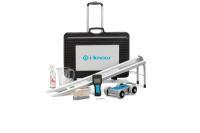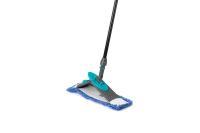You are reading: How Do You Know If A Surface Is Really Clean?
09 September 2022
6min read time
Brooke Payne
How Do You Know If A Surface Is Really Clean?
Share:

Key Insights
- There are multiple ways to check if a surface is really clean
- This includes checking with UV light, Aerobic plate count and ATP Testing
- APT Testing tells you how clean your surface or area is. You can use this information to determine if the environment is clean enough for its purpose.
When it comes to commercial cleaning in Australia, knowing what is clean is critical. Food production plants, high-touch points such as door handles and tapware, office equipment, kitchens – these are all areas where it is essential to be sure that surfaces are clean and hygienic to prevent the spread of potentially harmful bacteria.
But how do we know if a surface is really clean? Does the fact that it has just been cleaned mean that it actually is? How can you tell if one method cleans better than another?
These are great questions, and there are several ways we can determine cleanliness. Here are four of them:
Visual inspection
The first and most rudimentary method of inspection is with the naked eye. This is effective for the most basic form of cleanliness inspection such as whether an expected routine cleaning process has been completed.
For example, if there is a daily process to sweep the floor in a manufacturing workshop that produces a lot of debris on the ground, a visual inspection will be sufficient to determine whether it's happened has happened. Or if you are expecting some dusty air conditioning vents to have been cleaned, a quick glance will confirm whether it's been done or not.
There are obviously no controlled or controllable standards available for a visual inspection. Hence the inherent limitations of this typical (and common) form of cleaning inspection.
UV light
UV light is a fast & effective way of detecting certain bodily fluids on a surface. Saliva and urine and other biological fluids are naturally fluorescent and will glow eerily when exposed to a UV light or UV torch. This makes UV light a quick and fast way for certain types of cleaning inspection. There are various forms of UV lights and torches which are readily available.
UV inspection is especially good for detecting urine stains on carpet, upholstery, and other soft surfaces which may not show up under natural light. In this way UV is great for detecting the source of an odour issue such as a urine stain.
Not all UV lights are equal and depending on how much natural or artificial light is in the room you may find it necessary to dim the lighting or close off sources of natural light to make staining show. The brighter and larger the stain, the more biological material you are likely dealing with.
UV light is limited to detecting a relatively narrow spectrum of biological matter. It definitely has a place however, as part of a full cleaning inspection kit.

Aerobic plate count
Aerobic plate counts are a measure of the micro-organisms on a product or surface. As such an APC test is an advanced and measurable way of determining the effectiveness of cleaning processes as a specific and comparable test outcome can be achieved.
APC testing requires specific scientific equipment and access to a scientific laboratory for test data. An APC test also requires skilled analysts in order to provide test outcomes. Generally the outcome of APC test results can take 2-4 weeks.
In a practical application there are numerous drawbacks to using APC testing. Not least of these is that due to the time taken to get a test result, an APC test cannot be used to assess and compare cleaning methods. For real valuable insight on the effectiveness of cleaning processes, an immediate answer is necessary so that process improvement can happen in the moment.
Considering these factors, APC is an expensive, time consuming process that is completely impractical for the commercial and healthcare cleaning scene.
ATP Testing
ATP testing is the generally accepted best-practice form of testing for surface cleanliness.
ATP is a common abbreviation for Adenosine Tri-Phosphate and is the universal energy carrier present in all living cells. It can be found in all organic matter, including human, animal and vegetable cells. Even body fluids, insects, bacteria, yeast, and moulds contain ATP.
An ATP test can't tell the difference between food residues and microbes, nor can it tell you what sort of bacteria are present on a surface. It does however indicate the presence of biological matter invisible to the naked eye.
Why is it the best way to test for cleanliness?
Simply put, the higher the ATP test result, the higher the risk of infection – if high levels of ATP are detected on a surface after cleaning, it means the cleaning process is inadequate and a detectable risk is still present.
How does it work?
An ATP test is delivered from a handheld testing device with a simple-to-use, all-in-one swab. The test is activated by a simple snap and squeeze action, and the results are typically available in less than one minute (depending on the testing unit used).
There are multiple benefits to the ATP testing method. These include:
- Instant access to feedback and assessment of surface cleanliness, allowing corrective action to be implemented immediately
- Rapid results, low cost and simple to use
- Enhanced levels of professionalism
- Measurable against recommended standards and prior test results
- Eliminates any argument over whether a cleaning process is acceptable
Read: Five steps to commercial restroom cleaning efficiency.
So what are the ATP standards?
And what is an acceptable level of clean? There are no universal pass/fail limits for ATP testing of cleaning performance. Surfaces and environments vary in form, function, contamination risk and cleaning routine. However there are some generally established norms that can be used as general guidance for various areas:

*Note: These are general guidelines only, and facilities and contractors should research and consider the right pass/fail scores for their application.
People Also Ask: FAQ's
How do we measure the effectiveness of cleaning?
Conduct Regular Inspections: Regularly check the cleanliness of the areas serviced to ensure standards are met.
Use a Cleaning Checklist: Implement a detailed checklist to track tasks completed and ensure all cleaning duties are addressed.
Monitor Cleaning Frequency: Ensure that cleaning tasks are performed as scheduled and according to the agreed frequency.
Collect Feedback About the Cleaning Service: Gather input from users and staff to assess satisfaction and identify any issues.
Analyze Cleaning Services Costs: Review and compare costs to ensure the service is cost-effective and provides good value.
Monitor Cleaning Services Productivity: Assess the efficiency and productivity of the cleaning service to ensure they are meeting performance expectations.
What is surface cleanliness?
Surface cleanliness can be categorized into five types:
Visible Contaminants: Includes substances like oil, grease, cutting oils, and drilling compounds.
Dust: Consists of blast media, soil, air particulates, and similar particles.
Salts: Encompasses all salts, with particular focus on chloride, sulfate, and nitrate ions.
What is a clean surface?
Surface cleaning involves removing dirt, dust, varnish, and other debris from an object’s surface. Effective cleaning can enhance the vibrancy of colors, clarify details, and reveal previously unseen aspects of the object.
References
https://www.in-tec.com.au/learning-centre/how-tell-surface-clean-atp-testing
Products Featured in this Article
Media and Insights
Join the movement that's changing what clean means.
Be part of a cleaner world. Get a live demo at a time that suits you.
Book a Demo

